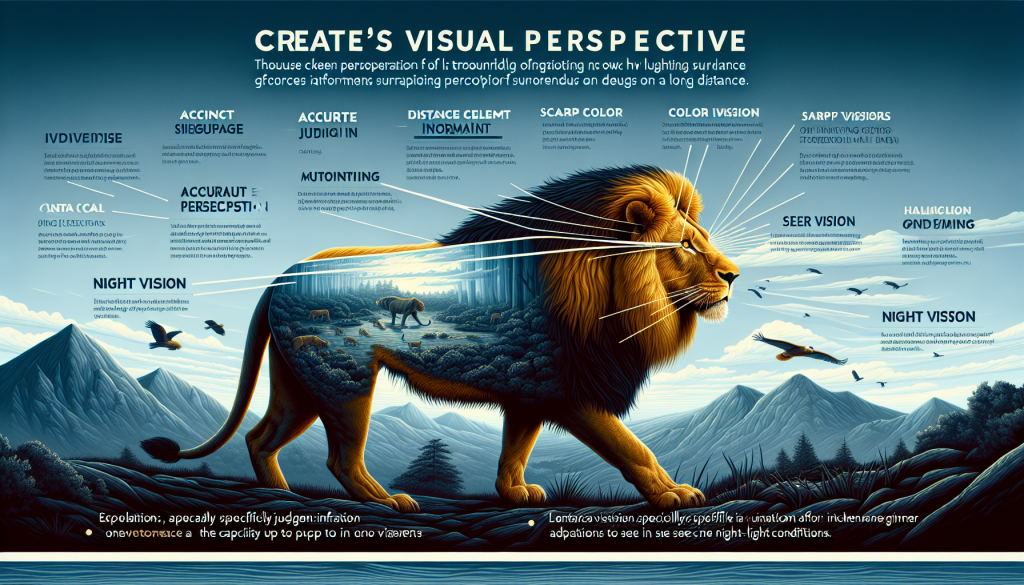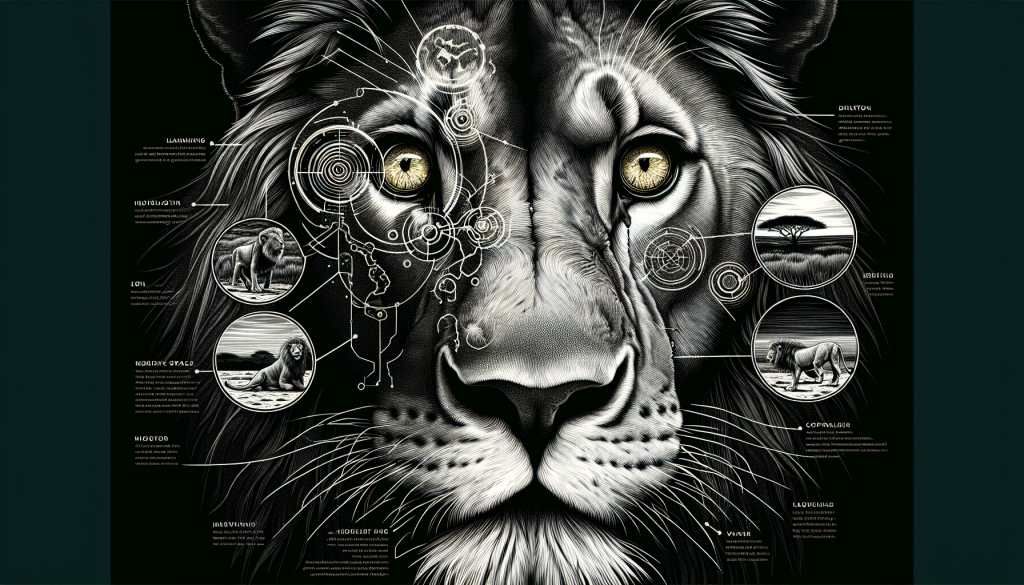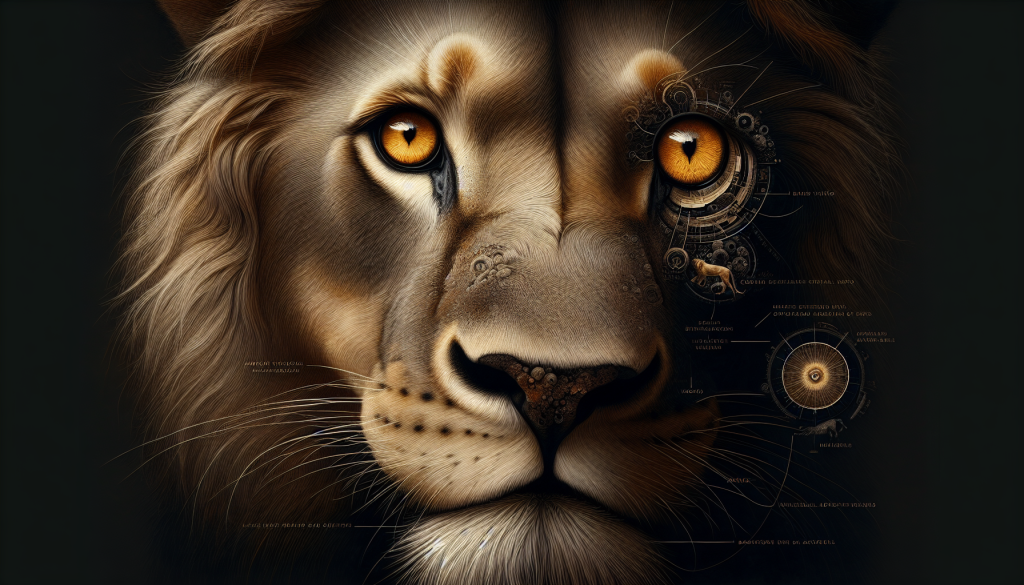You’re probably wondering about the eyesight of these majestic creatures – lions. Well, let me tell you, they have more than just good eyesight. Lions possess remarkable visual prowess that not only helps them navigate their vast territories but also aids in their hunt for prey. From spotting potential threats to locking onto their target, their keen eyes are a crucial factor in their survival in the wild. So, let’s take a closer look at the incredible eyesight of lions and uncover the secrets behind their optical abilities.

An Overview of Lions’ Eyesight
Introduction
When it comes to the animal kingdom, lions are often seen as majestic creatures with a multitude of impressive traits. One aspect that truly stands out is their remarkable eyesight. Lions possess eyes that are not only captivating in appearance but also highly functional in enabling them to hunt, navigate their environment, and communicate with their pride. In this article, we will delve into the fascinating world of lions’ eyesight, exploring its importance, physical characteristics, visual acuity, color vision, nocturnal adaptations, field of vision, factors affecting eyesight, the eyesight of lion cubs, and the interaction between their hearing and eyesight.
Importance of Eyesight for Lions
The eyesight of lions plays a vital role in their survival and success as apex predators. As carnivores and hunters, lions heavily rely on their eyes to identify and track potential prey across the vast savannah. Additionally, their eyesight aids in establishing dominance within their pride, as it allows them to navigate their surroundings and defend their territory effectively. Moreover, lions’ eyesight also plays a crucial role in their social interactions, helping them communicate and bond with their fellow pride members.
Comparison with Other Animals
As we explore the eyesight of lions, it’s intriguing to compare it with that of other animals. Lions’ eyesight, while impressive, differs from various species. For instance, in comparison to humans, lions have significantly better night vision, thanks to their unique adaptations. On the other hand, in terms of visual acuity and color perception, humans surpass lions. Understanding these differences can shed light on the capabilities and limitations of lions’ eyesight.
Physical Characteristics of a Lion’s Eyes
Eye Color
One cannot help but be captivated by the mesmerizing golden color of a lion’s eyes. Lions are known for their amber or golden eye color, which adds to their majestic appearance. The specific shade varies among individuals, but the warm tones of their eyes give them an intense and focused gaze.
Size and Shape of the Eyes
The size and shape of a lion’s eyes are specifically adapted to maximize their visual capabilities. Lions have large eyes, which allow more light to enter and enhance their ability to see in low light conditions. These eyes have a prominent round shape, providing a wide field of vision and ensuring that they can spot potential prey or threats from various angles.
Eye Structure
The internal structure of a lion’s eyes is well-designed to accommodate their needs as apex predators. Like humans, lions have a cornea, pupil, iris, lens, and retina. However, it is the intricate details in the structure of their eyes that enable them to have such impressive eyesight. For instance, the lens of a lion’s eye is flatter than that of humans, allowing them to focus better on distant objects. Additionally, they possess a tapetum lucidum, a reflective layer behind their retina that enhances their vision in low light conditions by reflecting light back through the retina.
Visual Acuity of Lions
Ability to See in Low Light
One of the most remarkable features of a lion’s eyesight is their exceptional ability to see in low light conditions. Lions are primarily nocturnal predators, and their eyes have adapted to function optimally during the dark hours. The large size of their eyes, coupled with the presence of a tapetum lucidum, enables them to gather and amplify even the tiniest amount of available light. This adaptation allows lions to hunt effectively during the night and gives them an advantage over their prey.
Detection of Motion
Lions’ eyes are finely attuned to detect movement across their field of vision. This skill is vital for hunting, as their agile and stealthy hunting techniques rely on spotting and tracking their prey’s movements. Their excellent motion detection capability ensures that they can identify potential prey from a distance, whether it’s a herd of grazing antelopes or a lone zebra navigating the grasslands.
Visual Acuity at Different Distances
A lion’s eyesight is highly adaptable when it comes to focusing on objects at different distances. While hunting, they demonstrate exceptional visual acuity in spotting prey from afar, thanks to their flatter lens, which aids in long-distance focusing. However, they may experience slightly reduced sharpness when objects are too close, as their eyes are not as adept at near vision as humans. Regardless, their ability to perceive detail is still remarkable and allows them to analyze their surroundings effectively.
Lions’ Color Vision
Presence of Color Receptors
While lions may not possess the same level of color vision as humans, they do have some ability to perceive certain colors. Like most mammals, lions have two types of color receptors, known as cones, in their retinas. These cones are sensitive to different wavelengths of light, allowing for limited color discrimination. While the exact range of colors they can perceive is not fully understood, it is believed that lions can differentiate between certain shades of yellow, blue, and green.
Range of Color Perception
Although lions’ color vision is limited compared to humans, it still influences their interactions and hunting strategies. The ability to discern certain colors, especially different shades of yellow, aids in identifying ripe fruits and leaves in their environment. Additionally, it allows them to evaluate the condition and overall health of prey animals based on their coloration, thereby assisting in selecting optimal targets during hunts.
Impact on Hunting Strategies
While their color vision may not be as extensive as humans’, lions rely more on other sensory cues, such as movement and scent, when hunting. Their excellent motion detection and acute sense of smell compensate for their limited color vision, ensuring their success in capturing prey. Nevertheless, the ability to perceive some colors still contributes to their overall hunting strategies, particularly in specific habitats and during certain times of the day.

Nocturnal Adaptations of Lions’ Eyes
Effect of Pupil Size
Lions have adapted remarkably to their nocturnal lifestyle, and one of the key adaptations is their ability to control the size of their pupils. During the day, a lion’s pupils constrict to a thin vertical slit, effectively managing the amount of light entering their eyes. However, as darkness falls and they need to maximize light absorption, their pupils dilate to a large circular shape, allowing for optimal light intake.
Tapetum Lucidum
Another crucial adaptation for nocturnal vision is the presence of a tapetum lucidum, mentioned earlier. This reflective layer within their eyes serves as a natural mirror, reflecting any incoming light back through the retina. By bouncing light back through their photoreceptor cells, the tapetum lucidum amplifies the limited available light, boosting a lion’s night vision significantly.
Specialized Rod Cells
Rod cells, the photoreceptor cells in a lion’s eyes responsible for detecting light and motion, play a pivotal role in their nocturnal adaptations. Lions have a high density of rod cells, enhancing their ability to perceive objects and movement in low light conditions. This specialized arrangement of rod cells in their eyes allows them to spot prey or potential threats even in the darkest hours of the night.
Lions’ Field of Vision
Binocular Vision
With their forward-facing eyes, lions possess binocular vision, allowing them to accurately judge distances and stereoscopic depth perception. This binocular vision is particularly useful during hunts, as it enables lions to assess the distance between themselves and their prey, precisely timing their attacks. The overlapping visual fields of their two eyes provide a comprehensive view, enhancing their ability to focus on a specific target.
Peripheral Vision
While their binocular vision grants precise depth perception, lions also have an excellent capacity for peripheral vision. Their wide-set eyes, coupled with a high number of photoreceptor cells throughout their retinas, result in a broad field of view. This peripheral vision allows lions to detect movement or potential danger from the sides, even when they are focusing intently on a specific target.
Field of View
The combination of binocular and peripheral vision gives lions an impressive field of view. They can observe a wide panorama, estimated to be around 180 degrees. This extensive field of view is beneficial for both their hunting techniques, as it ensures they don’t miss any potential prey movements, and for their survival, as it enhances their situational awareness in a dynamic and ever-changing natural habitat.

Factors Affecting Lions’ Eyesight
Age
Like any living organism, lions’ eyesight can be influenced by age. As lions grow older, their eyesight may gradually deteriorate, affecting their overall visual acuity. However, it is important to note that the decline may not be significant until their advanced years. Younger lions generally possess sharp and keen eyesight that peaks during their adult years, allowing them to thrive in their habitats.
Health and Injuries
A lion’s eyesight can also be affected by health conditions and injuries. Eye infections, cataracts, and other ailments can impair their vision, hindering their ability to hunt effectively. Additionally, injuries to their eyes sustained during confrontations with prey or rival predators can have long-lasting effects on their eyesight. Lions’ well-being and access to veterinary care play a crucial role in maintaining optimal eyesight throughout their lives.
Environmental Conditions
The environmental conditions in which lions reside can also impact their eyesight. Factors such as dust, glare from bright sunlight, or dense vegetation can temporarily hinder their visual clarity. However, lions have adapted to such conditions over millennia, possessing eyes that can adjust to varying lighting situations, enabling them to thrive in diverse environments, from open grasslands to dense forests.
Eyesight of Lion Cubs
Developing Visual Skills
Lion cubs are born with their eyes closed, and it takes around 10-14 days for them to begin opening their eyes. As they gradually gain control over their eye muscles, their vision begins to develop, and they start exploring their surroundings visually. This process allows them to familiarize themselves with the visual cues of their environment and prepare for their future roles as hunters.
Dependence on Sight
During their early development, lion cubs heavily rely on their eyesight, much like their adult counterparts. They observe and learn from their mothers and pride members, honing their visual skills and understanding how to navigate their surroundings. Their growing eyesight aids in their coordination, playfulness, and eventual transition into competent hunters within the pride.
Role in Bonding with Mothers
Visual communication plays a significant role in the bonding between lion cubs and their mothers. Through eye contact, cubs establish a secure attachment and develop trust with their mothers. This visual connection is crucial for the cub’s emotional development, as it builds the foundation for future social interactions within the pride.

Interaction between Hearing and Eyesight
Supplementary Role of Hearing
While lions primarily rely on their eyesight for hunting and survival, their hearing acts as a valuable supplementary sense. Lions’ acute sense of hearing assists them in locating prey, detecting approaching threats, and coordinating effectively within their pride. The combination of their exceptional eyesight and acute hearing ensures they have multiple sensory tools to navigate their habitats successfully.
Coordination for Hunting
The interaction between lions’ hearing and eyesight is particularly evident during group hunts. Lions communicate through vocalizations, such as roaring and growling, which assist in coordinating their movements during hunts. Their hearing allows them to pinpoint the location of other pride members, ensuring coordinated attacks that increase their chances of capturing prey successfully.
Effects on Communication
Lions’ eyesight and hearing also contribute to their communication within the pride. Visual cues, such as direct eye contact or body postures, convey important messages among pride members. These visual signals, combined with vocalizations and scent-marking, form a complex communication system that strengthens social bonds, establishes dominance hierarchies, and ensures efficient cooperation within the pride.
Conclusion
The eyesight of lions is truly remarkable, allowing them to thrive as one of the most formidable predators in the animal kingdom. From their captivating eye color and physical characteristics to their exceptional visual acuity, nocturnal adaptations, and wide field of vision, lions’ eyes are finely tuned for their role as hunters and social beings. While their color vision may be limited, their ability to adapt to various environmental conditions and the intricate interaction between their hearing and eyesight make them formidable and successful predators. Lions’ eyesight is a testament to the wonders of nature and serves as a constant reminder of the marvels that exist within the animal kingdom.

